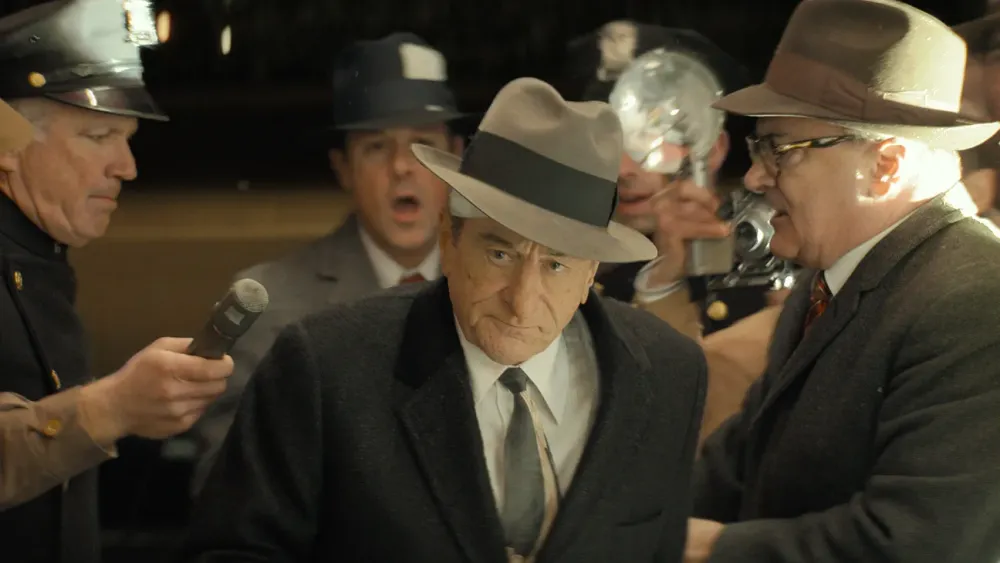Combining the writer of Goodfellas, the director of Bugsy, and starring Robert De Niro twice, The Alto Knights, based on the relationship between two New York Mafioso - Frank Costello (De Niro) and Vito Genovese (De Niro), isn’t Barry Levinson’s finest hour. In fact, it’s no-one’s finest “mob film” hour. The Alto Knights is, at best, a television film but not a prestige one. The film’s final message appears to be that ultimately the mob was a group of “morons and maniacs” who lucked into working hand in hand with America’s easily corrupted local political and law enforcement systems in the early twentieth century. The demise of “The Five Families” was inevitable when organised crime turned to narcotics as a main revenue source putting the syndicates in the line-of-sight of senate inquiries and federal entities.
In 1957 Frank Costello is one of the most powerful leaders of The Commission and the National Crime Syndicate. Known as a “professional gambler,” Costello is a kingmaker who operates with subtlety. A man in a stable marriage to Lauretta “Bobby” Geigerman (Debra Messing) since 1918, Frank keeps his nose clean enough that he’s able to socialise and be photographed with New York powerbrokers. He pays his taxes, hosts charity events, and walks his mink-coated dogs in Central Park. Everything changes when Vito Genovese orders Vincent “The Chin” Gigante (Cosmo Jarvis) kill Frank. Surviving a bullet to the head, Frank decides it’s time to retire but not before crippling the Mafia.
Frank Costello gives a potted history of his rise through the ranks of the mob. From his poverty-stricken beginnings in Italian Harlem and Little Italy where he met Vito Genovese through mob hangouts, specifically the social clubs and fronts for Charles “Lucky” Luciano and other heavy hitters. Both Frank and Vito were “made men” who survived gangland wars and thrived during prohibition. Frank’s quieter business and political acumen earned him the nickname “The Prime Minister” while Vito Genovese’s style was flashier, more violent, and volatile.
“We didn’t think the same,” narrates Costello as he describes Genovese’s gritty and grasping gangster nature. They were bedfellows in crime with Genovese relishing the hands-on approach while Costello was more strategic. Speakeasies, bootlegging, extortion, and gambling consolidated mafia power in New York and across America. Genovese fled America in 1937 to Italy to avoid a murder charge losing his prominence in the Luciano organisation. Costello who had been consigliere to the Luciano was proclaimed underboss in Genovese’s absence. On Genovese’s return in 1945 he began to pressure Frank for his previous title. Feeling under-rewarded and under appreciated, Vito’s jealousy and spite curdles into rage with his former friend and associate, especially when his marriage to drag club owner Anna Petillo (Kathrine Narducci) falls apart in a spectacularly public manner.
Nicholas Pileggi’s encyclopaedic knowledge of the Italian-American mob is undeniable, but his script is translated onscreen into a barely coherent mess of what audiences understandably now read as cliches. Shouting, shooting, baroque descriptions of Mafia rules, laws, and etiquette become confusing and redundant. This guy killed that guy without permission from another guy leading to unwanted attention and headlines during some period that could be 1946 through to 1958.
Robert De Niro, despite heavy prosthetics, fails to make his dual roles distinct. Costello is the calmer, friendlier, Don with the large nose and neat suits. Genovese is the shorter one wearing a hat and glasses. Then there is older Costello whose voice over occasionally turns into him addressing the audience years after the events. Other characters such as Michael Rispoli’s Albert Anastasia (Frank’s ally and longtime friend) becomes equally indistinguishable in the overly stuffed narrative until the drawn-out sequence of his demise.
Levinson’s film simply tries to encompass too much. There’s Costello’s public humiliation in the Kefauver Committee hearings in 1951. Genovese’s mistakes and public rampage through his district. Constant courtroom scenes, jail terms, unfortunate “accidents” leaving a trail of bodies. The narrative jumps around in time and eventually culminates in an overlong and absurd partially fictional recreation of an ill-starred National convention in upstate New York that has mob bosses fleeing the local cops on foot through muddy fields.
Frank Costello and Vito Genovese were famous organised crime figures whose combined “real” stories are more than dramatic enough for a film without Peleggi adding an entirely fictional story hook. Unlike Levinson’s Bugsy starring Warren Beatty, The Alto Knights isn’t anyone’s passion project. Instead, it’s a long gestating eventuality that Irving Winkler has had on his books since the 1970s. The Alto Knights emerged too late, wearing the knowledge that “times change.” Unless a major director such as Scorsese, Michael Mann, or Francis Ford Coppola took the helm, in the 2020s The Alto Knights was bound to be an also ran.
Director: Barry Levinson
Cast: Robert De Niro, Cosmo Jarvis, Debra Messing, Kathrine Narducci
Writers: Nicholas Peleggi
Producers: Irving Winkler, Charles Winkler, Barry Levinson
Music: David Fleming
Cinematography: Dante Spinotti
Editor: Douglas Crise
Streaming Availability:

